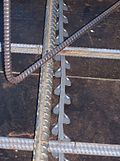- Concrete cover
-
Concrete cover, in reinforced concrete, is the least distance between the surface of embedded reinforcement and the outer surface of the concrete (ACI 130). The concrete cover depth can be measured with a cover meter.
Contents
Purpose of provision of concrete cover
The concrete cover must have a minimum thickness for three main reasons:
- to protect the steel reinforcement bars (rebars) from environmental effects to prevent their corrosion;
- to protect the reinforcement bars from fire, and;
- to give reinforcing bars sufficient embedding to enable them to be stressed without slipping.
The premature failure of corroded steel reinforcements and the expansion of the iron corrosion products around the rebars are amongst the main causes of the concrete degradation. The carbon steel of rebars is protected from oxidation by atmospheric oxygen by the high pH of concrete interstitial water. Iron bar surface is passivated as long as the pH value is higher than 10.5. Fresh cement water has a pH of about 13.5 while evolved cement water pH ~ 12.5 is controlled by the dissolution of calcium hydroxide (portlandite). Carbon dioxide present in the air slowly diffuses through the concrete cover over the rebar and progressively reacts with the alkaline hydroxides (KOH, NaOH) and with calcium hydroxide leading to the carbonation of the hydrated cement paste. As a result, the pH of the cement drops and when its value is below 10.5 – 9.5, steel surface is no longer passivated and starts to corrode. A sufficient thickness of concrete cover is thus required in order to slow down the carbonation process towards the rebar. The minimum concrete cover will depend on the environmental conditions encountered and must be thicker when the concrete is also exposed to moisture and chloride (proximity to the sea, use of de-icing salt for bridges or roads, ...). A high quality concrete made with a low water-to-cement (w/c) ratio will have a lower porosity and will be less permeable to water and to the ingress of corrosive species (dissolved oxygen, chloride, ...). A thicker cover or a more compact concrete will also reduce the diffusion of CO2 in the concrete, protecting it better from carbonation and maintaining a higher pH for a longer time period, increasing so the rebar service life.
Guidelines
National codes also specify minimum cover requirements based on their respective local exposure conditions.
Other National Concrete Cover Requirements Country Concrete Code Range of Concrete Cover
(mm)UK BS:8110 25-50 EU EN 1992 (EC2) diameter +10 - 55 USA ACI:318 40-50 Australia AS:3600 15-30 Paradox
Large cover depths (50–75 mm) are required to protect reinforcement against corrosion in aggressive environments, but thick cover leads to increased crack widths in flexural reinforced concrete members. Large crack-widths (greater than 0.3 mm) permit ingress of moisture and chemical attack to the concrete, resulting in possible corrosion of reinforcement and deterioration of concrete. Therefore, thick covers defeat the very purpose for which it is provided. There is a need for judicious balance of cover depth and crack width requirements.
A possible economical solution for this paradox is the placing of a second layer of corrosion-resistant reinforcement like stainless steel rebars or meshes or FRP rebars in the concrete cover to distribute the cracks.
Methods of maintaining cover
See also
Categories:- Concrete
- Construction terminology
Wikimedia Foundation. 2010.





